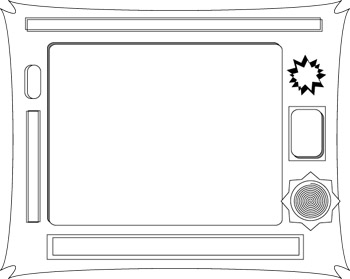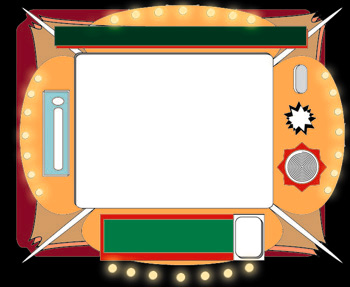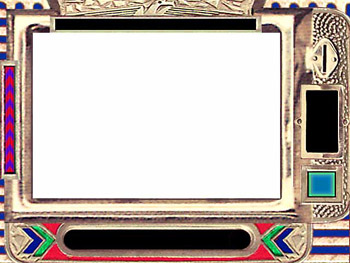
This black and white drawing is most likely a second or third draft done in Adobe Illustrator. The original sketch was done on a napkin, in a parking lot, near Potrero Hill, San Francisco. The challenge was to somehow come up with a static interface that would nonetheless keep the reader entertained. Much has been written about interactivity and the changing role of the reader-cum-user. Our strategy presumes that reading, really reading something, is still the most interactive experience. We only regret that the user cannot write on the margins or tear pages out. Then again, there are moments throughout the CD-ROM where opportunities for "gaming" take place. These miniature video games break apart the experience of reading a book with a moment that is altogether cheap and silly. We hope.
 The importance of capturing Vegas in the interface is quite dramatically rendered in this illustration. Thankfully, the Jetson's never got hold of this deco design. Despite all the fluorishes, the basic components of the final interface design are already here--and then some. There were to be multiple windows for various types of information (coins, rolls of paper, pencils, a movement joystick, etc.) and the importance of the central screen had clearly not yet been developed in this sketch. As The Réal became more of a readerly rather than visual project, this central screen grew out to encompass the greater part of the screen.
In the end, the kind of Vegas we "painted into" the design is based on a nostalgia for the one-armed bandit. This, "instant classic" slot machine [seen below] is rooted in the opening words of The Réal, in which sand swallows Vegas whole.
The importance of capturing Vegas in the interface is quite dramatically rendered in this illustration. Thankfully, the Jetson's never got hold of this deco design. Despite all the fluorishes, the basic components of the final interface design are already here--and then some. There were to be multiple windows for various types of information (coins, rolls of paper, pencils, a movement joystick, etc.) and the importance of the central screen had clearly not yet been developed in this sketch. As The Réal became more of a readerly rather than visual project, this central screen grew out to encompass the greater part of the screen.
In the end, the kind of Vegas we "painted into" the design is based on a nostalgia for the one-armed bandit. This, "instant classic" slot machine [seen below] is rooted in the opening words of The Réal, in which sand swallows Vegas whole.

Sand or silicon, the coppery, faux-historical look of The Réal's interface is a reassuring anchor of physicality in a sea of information. (Art critics stand back.) In all seriousness, though, the combination of patriotic and desert themes, deep and dark blues, reds and greens (from the color of most betting chips) and the presence of a grainy, metallic texture are awesome achievements. Ralph, who put together the interface, is an illustrator who works for such traditional print venues as Harper's and the Wall Street Journal. That conservative flair shows up quite nicely in the context of Mamey-styled robot maids, ice skating showgirls and an alien security guard pin up doll. For the detail-oriented: notice how thin the coin slot is on the top right hand corner. When the animated coins were brought in [see below], they obviously didn't fit. Luckily, this slot machine/scrapbook only exists in digital space and the proper repairs were made in a matter of seconds.




